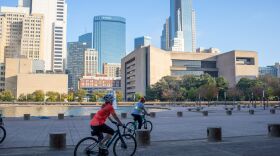Dallas’ traffic fatality rate ranks fifth highest among the 25 most populous cities in America. And it has the highest rate among Texas’ six largest cities.
The audit concluded that budget cuts to the city’s transportation department for crosswalk maintenance is part of the problem. The budget has been reduced by more than $400,000 since fiscal year 2016, according to the audit.
It also said that there’s also not enough staff to do the work. In a city with thousands of crosswalks, the city’s transportation department has seven people managing crosswalk maintenance.
And City Auditor Mark S. Swan said, “the Dallas Department of Transportation does not have performance measures and written procedures directly related to pedestrian safety.”
Nor does the city have procedures for collecting, analyzing, and using pedestrian accident data to improve safety conditions at high injury locations.
“The Dallas Department of Transportation takes the findings of this audit very seriously," Department of Transportation Director Gus Khankarl said. "Creating a safe transportation system for all users of our roadways, including pedestrians, is our top priority. "
The city does have plans to address many of the issues raised by the audit, like Dallas’ Vision Zero Plan, which seeks to eliminate traffic fatalities and achieve a 50 percent reduction in severe injuries by 2030. And the city’s Sidewalk Master Plan aims to improve pedestrian safety by fixing sidewalks that are broken or too narrow — and to build new ones. But it’s hard to tell how effective those plans have been.
Khankarli said the city plans to have the Vision Zero Action Plan on the Council Agenda for adoption next month. That, he said, "will allow for an integrated approach to our commitments as noted in the audit report’s findings.”
The audit also found:
- Dallas has a backlog of 1,500 crosswalks that need to be remarked, which would cost about $1.2 million.
- The city has a yearly goal of re-marking 830 crosswalks, but last fiscal year funded only 70 crosswalks. That's less than 1% of the year goal.
- Dallas doesn’t have any set criteria for when it should investigate intersections with multiple pedestrian incidents.
- Dallas does not have any criteria for when to conduct a traffic study or road safety audit to evaluate intersections with multiple pedestrian incidents.
The audit recommended creating a list of procedures to decrease the number of pedestrians hit in traffic; developing a plan to repaint 1,500 faded crosswalks; and coming up with maintenance schedules to refresh crosswalk markings.
Dallas residents have already been sharing their thoughts about the audit's findings.
Jerry Hawkins, executive director of Dallas Truth, Racial Healing & Transformation said he wants public officials to be held accountable for not having a plan.
"Because this is dangerous. How do we create a relationship of accountability & priority around walkable communities?” he tweeted.
Krista Nightengale, the executive director of the nonprofit Better Block in Dallas, says the city should create a program that lets residents incorporate art into roadways and crosswalks to increase visibility of pedestrians and promote walkability.
"It'll only last a few months, but creates engagement, gets the crosswalks to pop, and buys the city time,” she tweeted.
Nightengale said that this solution has proven effective in other cities. A study by Bloomberg philanthropies said that kind of public art on city streets resulted in 50% drop in crashes involving pedestrians or cyclists and a 37% drop in crashes leading to injuries.
Swan said the Government Performance and Financial Management Committee will be briefed on the report next month.
Got a tip? Alejandra Martinez is a Report For America corps member for KERA News. Email Alejandra at amartinez@kera.org. You can follow Alejandra on Twitter @alereports.
KERA News is made possible through the generosity of our members. If you find this reporting valuable, consider making a tax-deductible gift today. Thank you.






